Types of Maple Trees encompass a diverse array of species, each offering unique characteristics and beauty. From the iconic Sugar Maple (Acer saccharum) known for its role in maple syrup production to the delicate Japanese Maple (Acer palmatum) prized for its ornamental foliage, maple trees span various sizes, shapes, and colors.
The Sugar Maple stands tall in North American forests, displaying vibrant red and orange leaves in autumn. Contrastingly, the Japanese Maple adorns gardens with its lace-like leaves and striking hues of red and green. Further variations include the compact Coral Bark Maple (Acer palmatum ‘Sango-kaku’) and the hardy Norway Maple (Acer platanoides), each contributing uniquely to landscapes worldwide.
This article provides a list of 35 types of maple trees to help gardeners easily differentiate and identify them.
Different Types of Maple Trees
Sycamore Maple Tree

Sycamore maple trees (Acer pseudoplatanus) are large deciduous trees that thrive in full sun. They have a rounded growth habit with large, broad leaves. Despite their name, they are not true sycamores but belong to the Acer genus. These trees grow to between 40 and 60 feet (12 and 18 meters) and are suitable for USDA zones 4 to 7.
The five-lobed leaves resemble sycamore leaves, with a rounded shape and serrated margins, growing 4 to 10 inches (10 to 25 cm) long. The bark becomes rough and scaly as it matures, revealing a pinkish-brown inner bark.
Amur Maple Tree
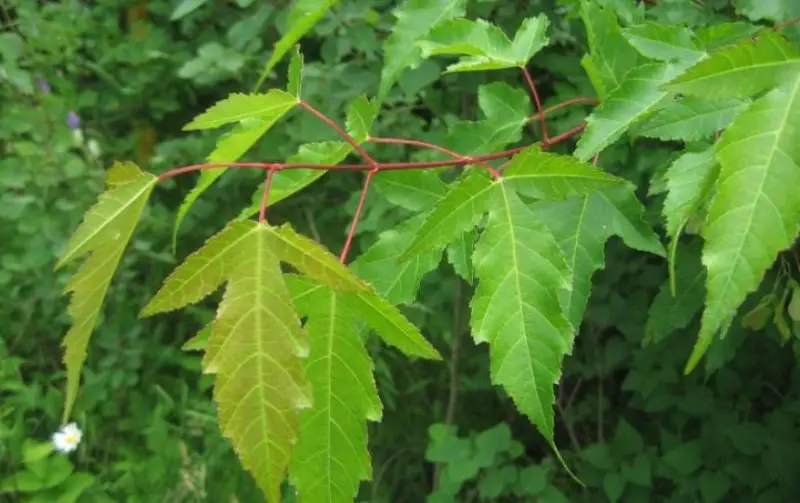
Amur maple trees (Acer ginnala) are large, multi-stemmed shrubs or small trees that grow to between 10 and 32 feet (3–10 meters) with a dense, rounded crown. These low-maintenance trees thrive in zones 2 to 8, tolerating full sun and poor soil conditions.
Their leaves are 2 to 4 inches (5–10 cm) long, typically with three or five lobes and toothed margins, turning red or yellow in autumn. The bark of Amur maple trees starts smooth and gray, gradually developing fissures as the tree matures.
Bigleaf Maple Tree
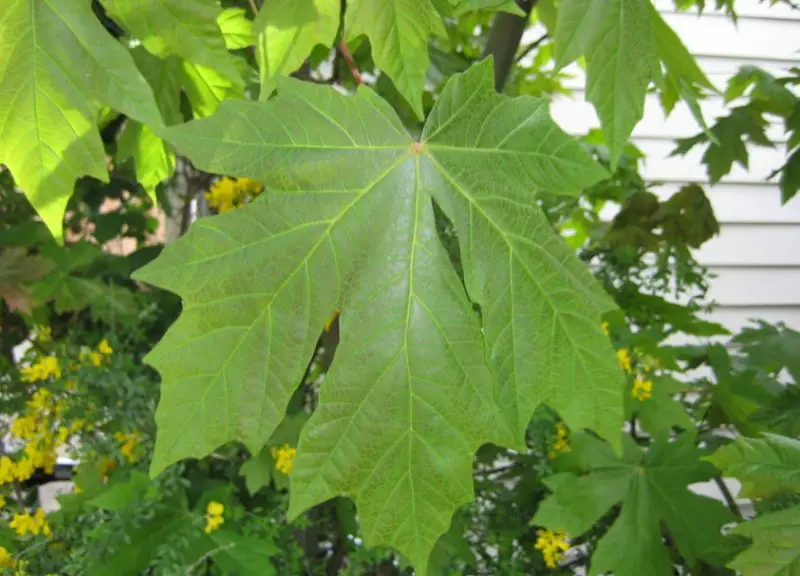
Bigleaf maple trees (Acer macrophyllum), native to North America and also known as Oregon maples, feature the largest leaves among maple species. These giants can reach heights of up to 158 feet (48 meters), with dark green foliage forming a broad-rounded crown. They thrive in zones 6 and 7.
Bigleaf maple leaves can grow up to 12 inches (30 cm) across, with five lobes and deep indentations, turning a striking golden yellow in autumn. The bark of mature Bigleaf maples is reddish-brown with deep furrows, adding to their majestic appearance.
Hedge Maple Tree
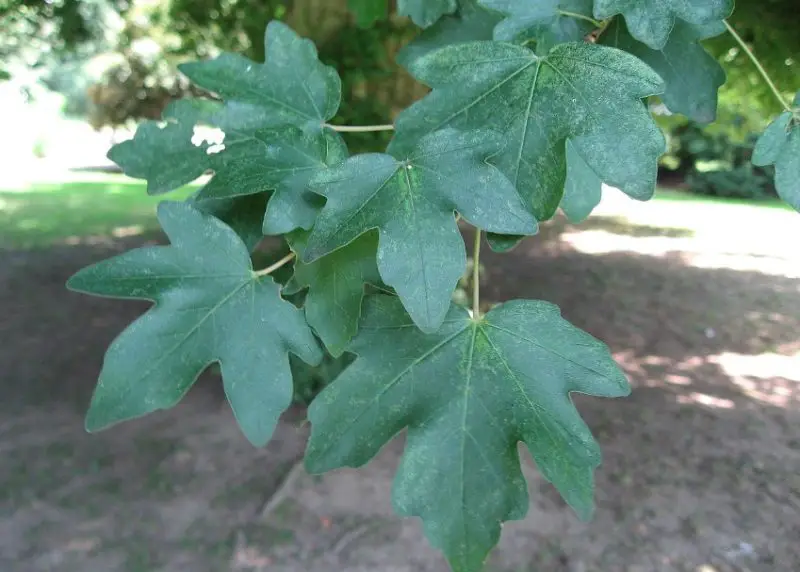
Hedge maple trees (Acer campestre), native to Europe, are medium-sized, fast-growing deciduous trees that reach heights of 50 to 80 feet (15–25 meters). Also known as field maples, they are among the last trees to change color in autumn.
The leaves of hedge maple trees have three to five rounded lobes with a shiny, dark green surface, turning golden yellow in the fall. The bark features deep fissures and has a unique, soft texture reminiscent of cork, distinguishing it from other maple species.
Hornbeam Maple Tree
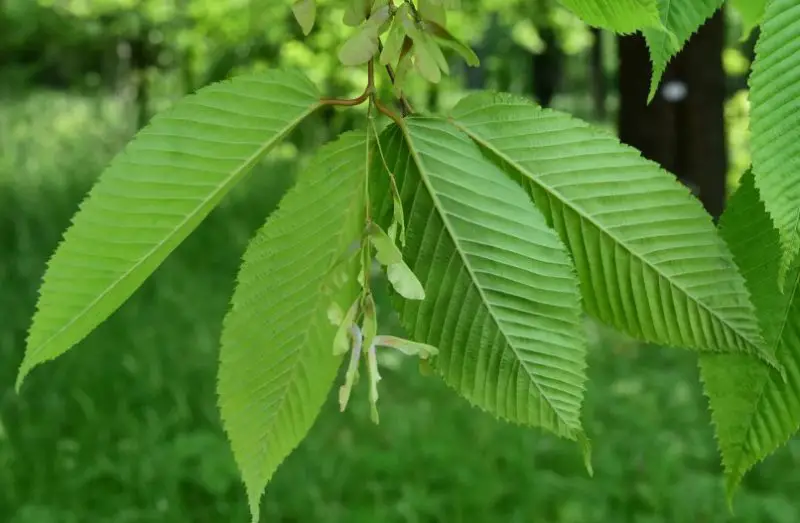
Hornbeam maple trees (Acer carpinifolium), native to Japan, are small trees with short trunks and a rounded growth habit. Unlike many other maple species, hornbeam maples have simple, unlobed leaves with serrated edges, reaching up to 6 inches (15 cm) in length.
They grow to between 20 and 30 feet (6–9 meters) tall and are hardy in zones 4–7. The bark of hornbeam maples is dark gray to gray-brown and has a smooth texture, distinguishing it within the maple family.
Tatarian Maple Tree
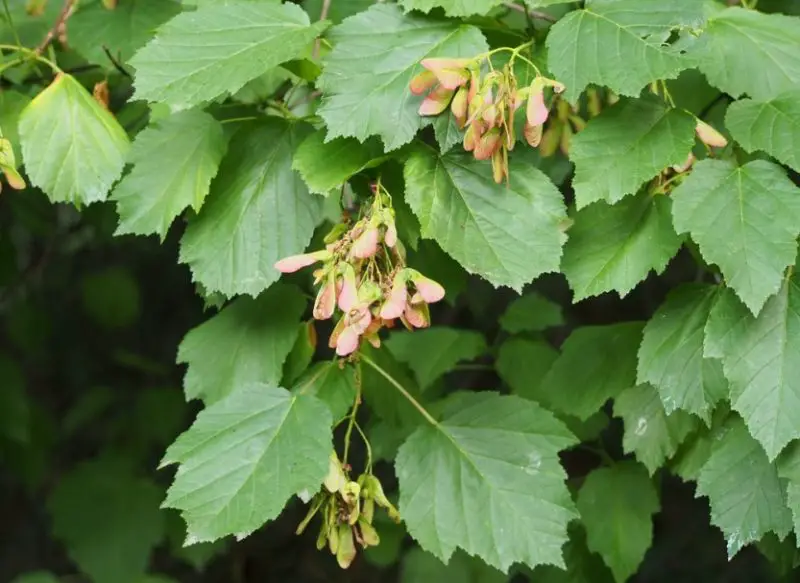
Tatarian maple trees (Acer tataricum) are small, slender-trunked trees reaching heights up to 20 feet (6 meters) with a similar spread. Native to Europe and Asia, these small maples thrive in zones 3 to 8, tolerating full sun or partial shade.
The leaves of Tatarian maples are either unlobed or have three to five shallow lobes, ovately-shaped and medium green, turning yellow or red in autumn. The bark is thin, smooth, and pale brown, gradually developing fissures as the tree matures, adding texture to its appearance.
Sugar Maple Tree
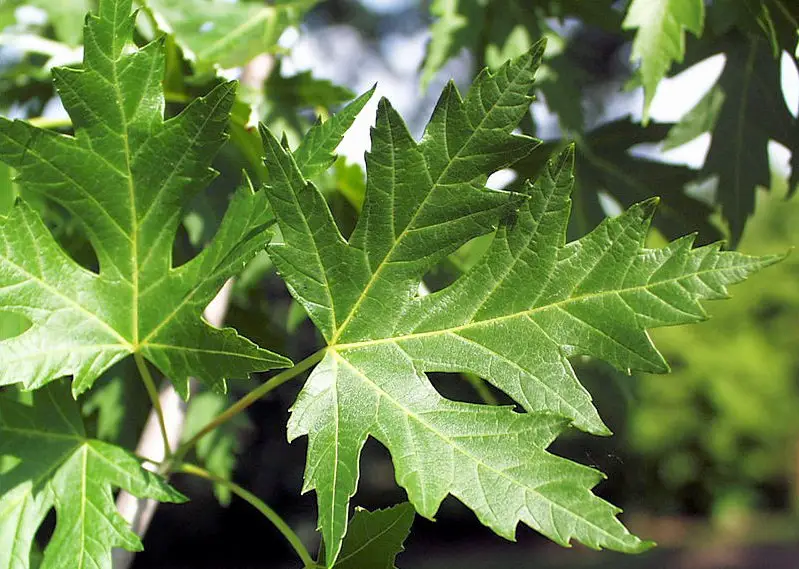
The Sugar Maple tree (Acer Saccharum) is a large, fast-growing deciduous tree that reaches heights of 40 to 80 feet. It thrives in full sun or partial shade and grows well in zones 3 to 8. The sugar maple is best known as the principal source of maple syrup and is Canada’s national tree.
Its leaves, typically five-lobed and deep green, turn brilliant shades of yellow, orange, or red in the fall. The bark is gray-brown with long, narrow grooves, becoming shaggy as the tree matures.
Red Maple Tree
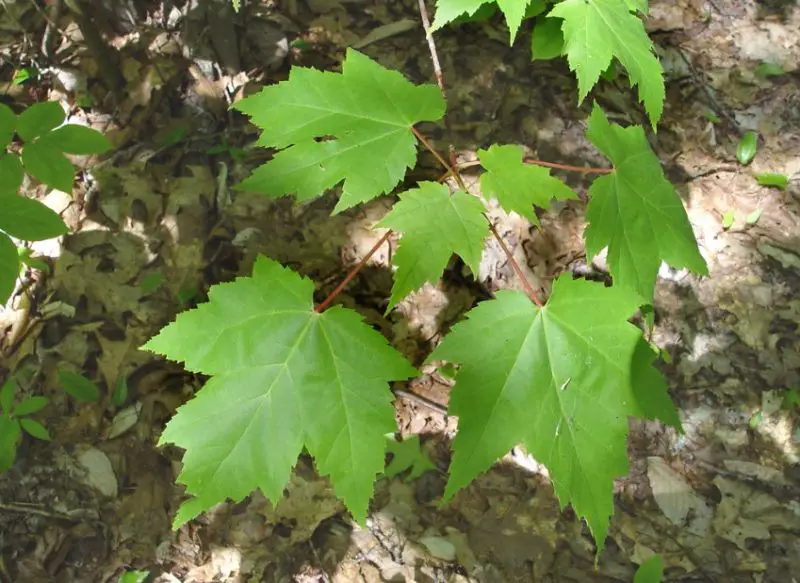
Red Maple trees (Acer Rubrum) are stunning landscape trees known for their spectacular red foliage in the fall. In spring, they produce reddish flowers, and their leaves transition from red to green, then yellow and red in autumn.
Red maples grow in North America, thriving in full sun or part shade and reaching heights of 40 to 70 feet. Suitable for zones 3 to 9, their leaves are light green with white undersides, and the bark is thin and smooth when young, developing furrows with age.
Japanese Maple Tree
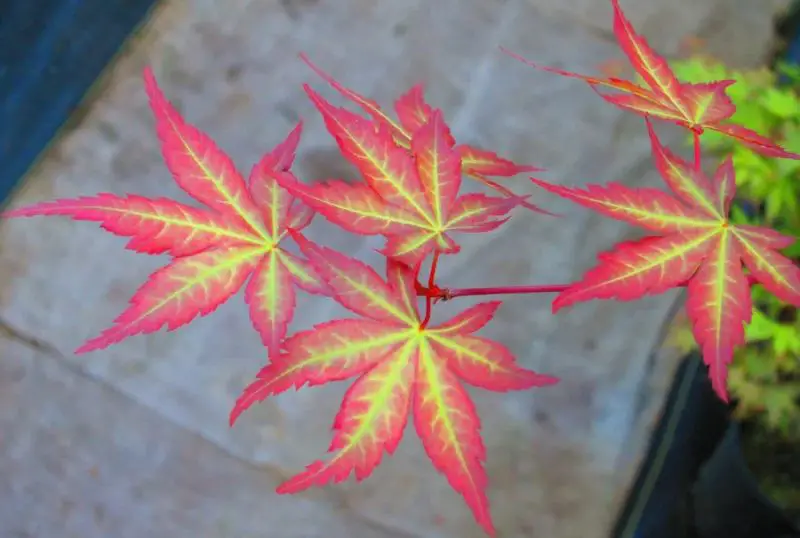
Japanese maple trees (Acer Palmatum) can grow up to 33 feet (10 meters) tall, with some dwarf varieties resembling small shrubs. Often growing as small, multi-stemmed trees, they have a dome-like canopy. In the fall, their stunning foliage turns yellow, bronzed, or deep red. Thriving in full sun to partial shade, Japanese maples grow in USDA zones 5–9.
Their leaves are palmately lobed with five to nine serrated lobes, resembling a hand. The bark is smooth and gray when young, developing furrows with age, and the ‘Sango-Kaku’ cultivar is notable for its showy pink bark.
Silver Maple Tree
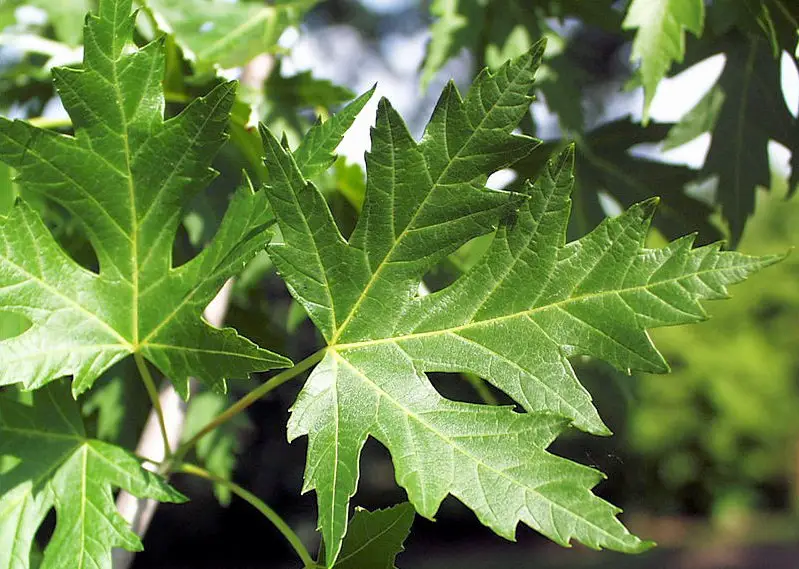
Silver maple trees (Acer Saccharinum) are fast-growing deciduous trees that reach heights of 50 to 80 feet (15–25 meters) with a spread of 36 to 49 feet (11–15 meters). Their five-lobed leaves are green on top and silver underneath. Silver maples thrive in zones 3 to 9 and are also known as creek maple, silverleaf maple, water maple, and swamp maple.
In the fall, their leaves turn yellow. The bark is smooth and silvery gray when young, becoming gray and shaggy as the tree matures.
Boxelder Maple Tree
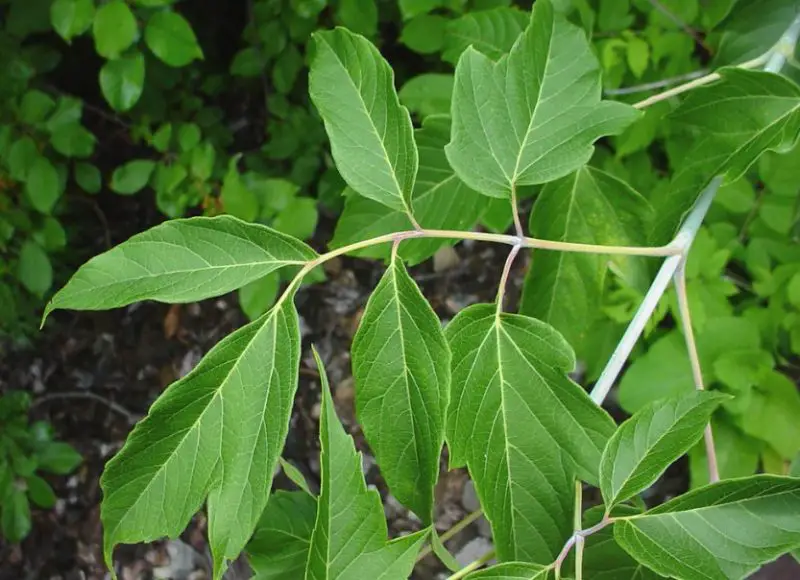
Boxelder maple trees (Acer Negundo), also known as Manitoba maples or ash-leaved maples, are fast-growing trees that can reach up to 80 feet (25 meters) and sometimes have multiple trunks. They thrive in zones 2 to 9 and prefer full sun or partial shade.
Their leaves, which generally have three lobes resembling poison ivy leaves, are light green in spring and summer, turning yellow in the fall. The bark is pale gray to light brown with deep fissures that become scaly over time.
Norway Maple Tree
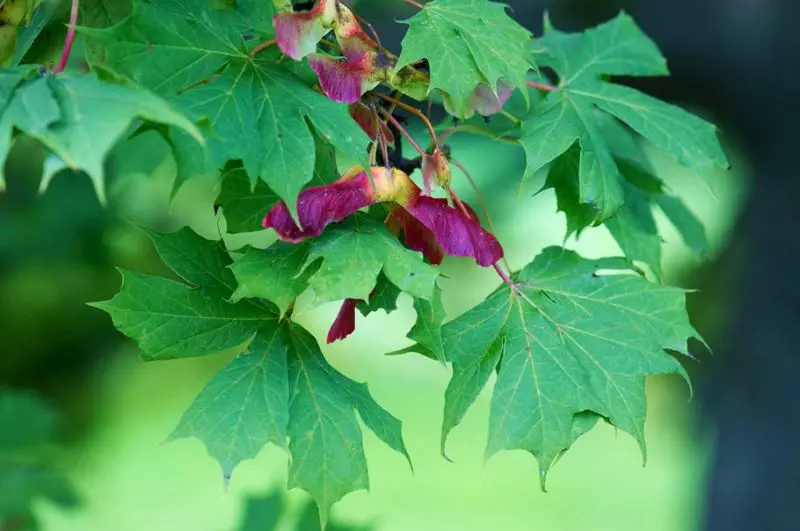
Norway maple trees (Acer Platanoides) are deciduous trees with a broad, rounded crown and distinctive maple-type leaves. Native to Europe, they thrive in zones 4 to 7 and can grow in poor soil, reaching heights of 65 to 100 feet (20–30 meters).
Their leaves, which have five lobes and can grow up to 5 inches (12 cm) across, typically have some teeth but a generally smooth margin. The bark is gray-brown and develops deep furrows as it matures.
Paperbark Maple Tree
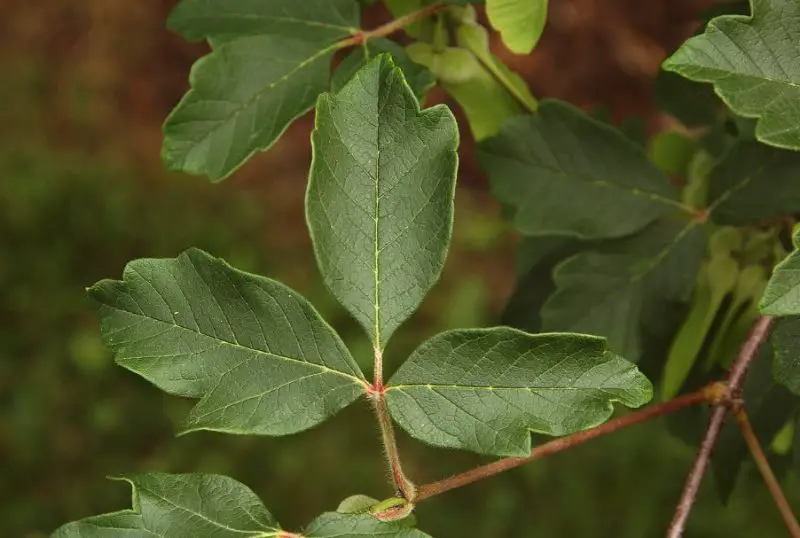
Paperbark maple trees (Acer Griseum) have smooth, shiny, orange bark that peels off in strips, displaying shades of cinnamon, orange, and reddish-brown. These trees grow to between 20 and 30 feet (6–9 meters) tall and thrive in zones 4–8.
Their leaves consist of three leaflets up to 4 inches (10 cm) long, dark green, with blunted teeth on the margins. The bark exfoliates in thin, papery shards, adding to its unique appearance.
Vine Leaf Maple Tree
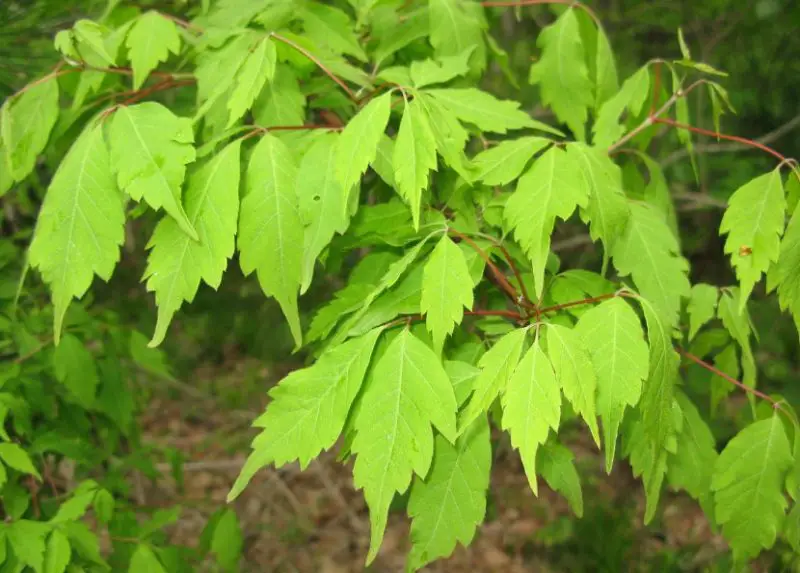
Vine leaf maple trees (Acer cissifolium) are large shrub-like trees with a rounded crown and dense foliage, resembling spreading ivy leaves. Thriving in zones 5 to 8, these trees have leaves composed of three ovate leaflets with serrated edges. Their medium green color transitions to vibrant shades of yellow and red in autumn.
The bark of vine leaf maple trees is smooth and gray, adding to the tree’s overall aesthetic appeal, especially when combined with its distinctive foliage.
Freeman Maple ‘Autumn Blaze’ Tree
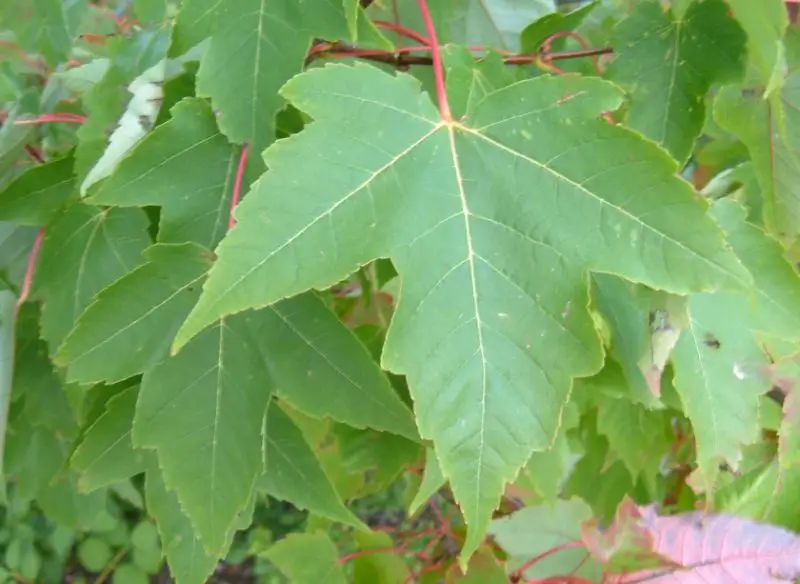
Freeman maples (Acer freemanii) are strikingly large trees known for their rounded crown, dense green foliage, and vibrant autumn colors. Among the most renowned cultivars is the ‘Autumn Blaze,’ celebrated for its brilliant transformation to orange and crimson-red hues in the fall. These maples typically reach heights of 50 to 60 feet (15–18 meters) and thrive in zones 3–8.
The leaves of Freeman maples have deep indentations between their lobes and sport a bright green color during the growing season. Their bark starts out smooth, thin, and gray, gradually developing slight furrowing as the tree matures.
Fullmoon Maple Tree
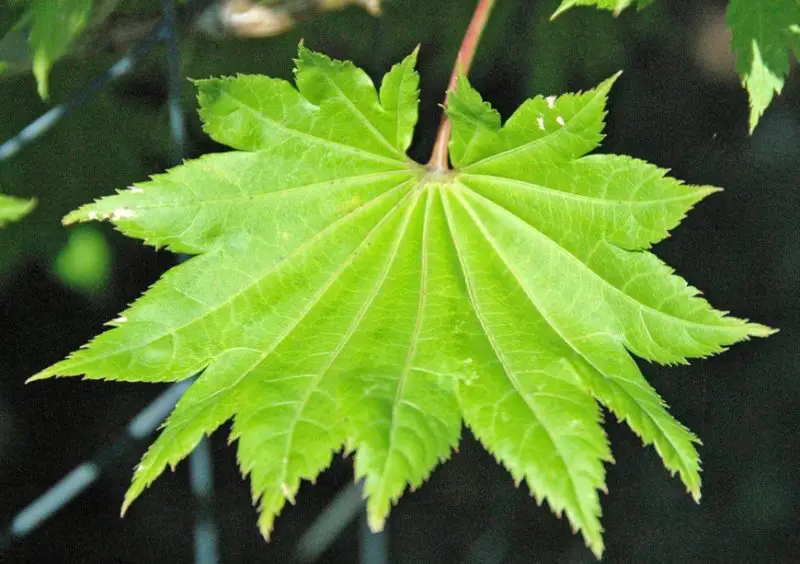
The Fullmoon maple (Acer shirasawanum), also known as Shirasawa’s maple, is a substantial shrubby tree native to Japan, growing between 26 and 50 feet (8 and 15 meters) tall. It is closely related to Acer japonicum, also known as the fullmoon maple or Amur maple.
Fullmoon maple leaves feature nine to thirteen shallow lobes, giving them a rounded shape with serrated edges. They are medium green in color, turning shades of golden orange to dark red in autumn.
The bark of the Fullmoon maple is smooth and gray, maintaining its texture without developing deep fissures as the tree matures.
Vine Maple Tree
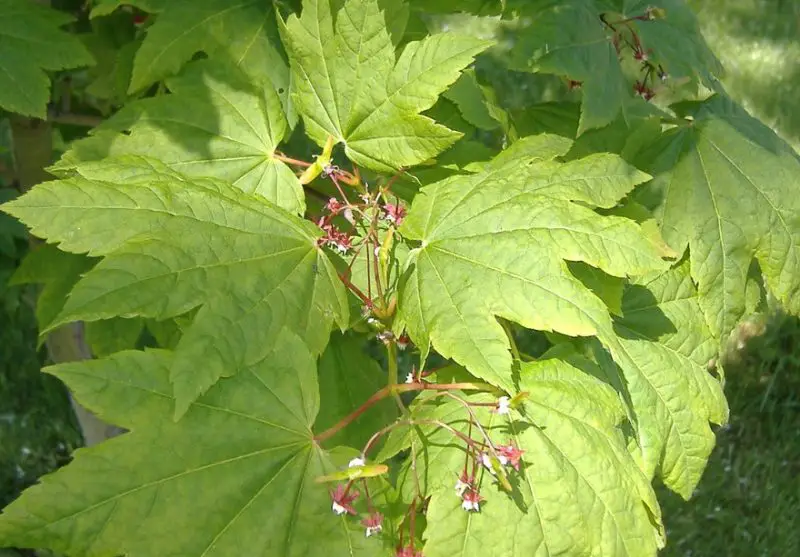
The vine maple (Acer circinatum) is a multi-stemmed, medium-sized tree native to North America, often resembling a large deciduous shrub. Known for its round leaves with seven to nine palmate lobes, red-winged samaras, and delicate white and purple spring flowers, it thrives in USDA zones 6 to 9. Growing 15 to 25 feet (4–8 meters) tall and up to 20 feet (6 meters) wide, it displays vibrant red and orange foliage in the fall before shedding its leaves.
Vine maple leaves are circular, measuring 3 to 5 inches (7.5–12 cm) long, with pointed lobes that turn from bright green to warm hues in autumn. The bark of the vine maple is reddish-green and relatively smooth.
Douglas Maple Tree
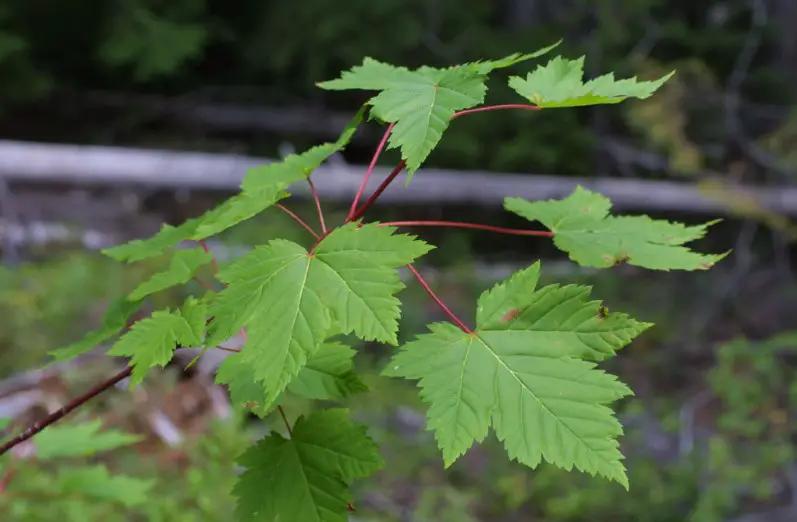
The Douglas maple (Acer glabrum var. douglasii) is a small tree characterized by its vase-shaped canopy and green leaves with serrated edges and three lobes. Growing 20 to 30 feet (6–9 meters) tall, it serves as an attractive landscape and shade tree.
This deciduous tree features flat-topped clusters of small yellowish-green flowers, winged fruits with a reddish tinge, and heart-shaped leaves. Young twigs emerge red and mature to reddish-purple or gray.
Douglas maple leaves have three to five pointed lobes, turning yellow, orange, or crimson red in autumn. Mature trees develop grayish to reddish-purple bark.
Bigtooth Maple
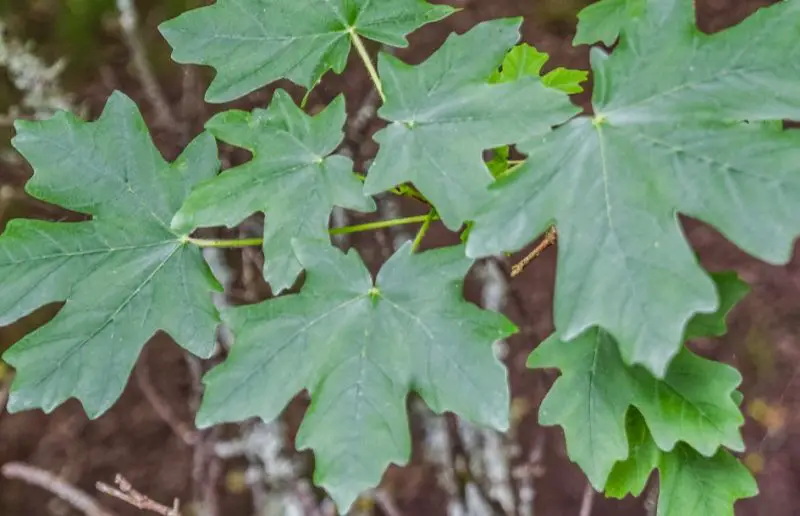
The Bigtooth maple (Acer grandidentatum) is a shrub-like tree with an upright, irregular crown, featuring green leaves with three to five lobes and broad, shallow spaces between them. It bears yellowish-green flowers and rose-colored winged samaras. Growing up to 50 feet (15 meters) tall and 25 feet (7.5 meters) wide, it thrives in sun and partial shade in USDA zones 4 to 9.
Bigtooth maple leaves, measuring 2 to 3.1 inches (5–8 cm) across, have rounded teeth on the lobes and a fuzzy underside. They turn spectacular shades of golden yellow to deep red in autumn. The bark of Bigtooth maples is dark brown and scaly.
Black Maple
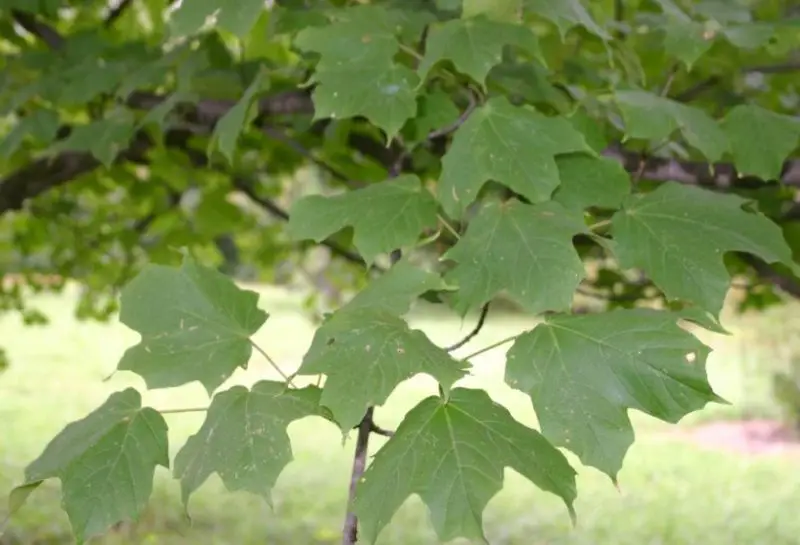
The black maple (Acer nigrum) is a tall deciduous tree native to North America, prevalent in the midwestern United States. Known for its green leaves with three or five lobes, deeply grooved bark, and clusters of yellowish-green flowers, it thrives in USDA zones 5 to 7, growing 70 to 100 feet (21–34 meters) tall.
Closely related to the sugar maple, its sap is also tapped for maple syrup production. Its leaves have a drooping appearance, fuzzy undersides, and a thicker petiole compared to the sugar maple. In autumn, the bright green foliage of the black maple transforms into vibrant shades of yellow, orange, and red-burgundy. The bark of the black maple is grayish-brown and develops rough, irregular furrows as it matures.
Florida Maple
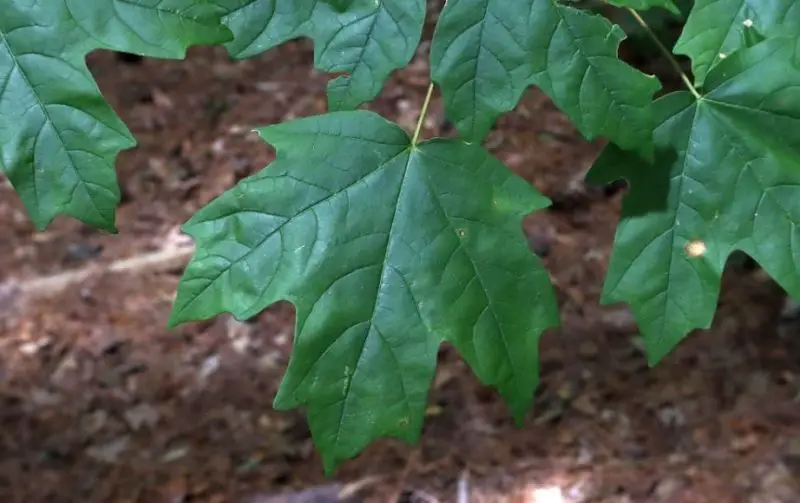
The Florida maple (Acer floridanum) is a medium-sized decorative tree with an oval to rounded crown, adorned by dark green leaves featuring three to five rounded lobes, greenish-yellow flowers, and two-winged samaras. Growing 20 to 60 feet (6–18 meters) tall, it thrives in USDA zones 6 through 9, making it ideal as a shade tree in southern gardens, including central Florida.
Its characteristic maple-shaped leaves have a pale underside, turning vibrant shades of orange and red in autumn. The bark of the Florida maple starts smooth and gray, aging to a shaggy, exfoliating texture in mature specimens.
Three-Flowered Maple
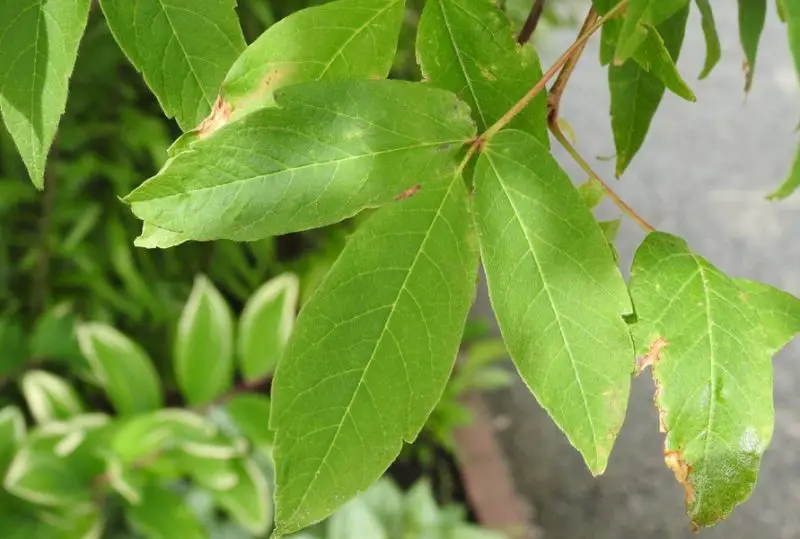
The three-flowered maple (Acer triflorum) is a small to medium-sized landscaping tree known for its spectacular light-ash-brown exfoliating bark. While it can reach heights up to about 82 feet (25 meters), it typically grows to 20–30 feet (6–9 meters). With a rounded form and dense foliage perfect for shade, it thrives in USDA zones 5 to 7 in full sun or partial shade.
Its trifoliate leaves consist of three lanceolate blades, turning brilliant red and orange in autumn. This slow-growing tree offers year-round interest with lush foliage in spring and summer, vibrant fall colors, and attractive peeling bark that reveals cinnamon-red or cinnamon-orange inner layers.
Pointed Leaf Maple
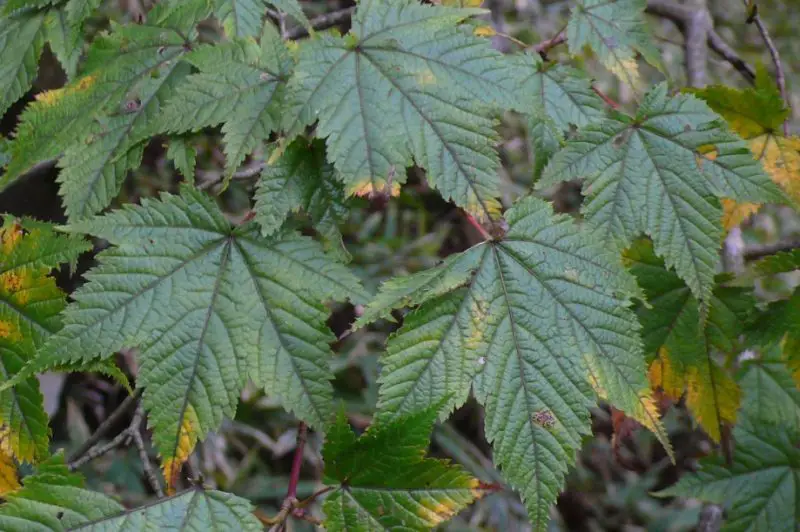
Pointed leaf maple (Acer argutum) is an attractive tree with an upright habit and a dense canopy of large, five-lobed leaves that taper to pointed ends. Native to Japan, it thrives in woodlands and near water bodies, reaching a height of 33 feet (10 meters). In fall, its foliage transitions from green to vibrant shades of yellow and orange.
This maple species also serves as a source of sugary sap, suitable for producing maple syrup. Its bark is smooth with patches of green, gray, and tan, adding to its visual appeal.
Sycamore Maple ‘Brilliantissimum’
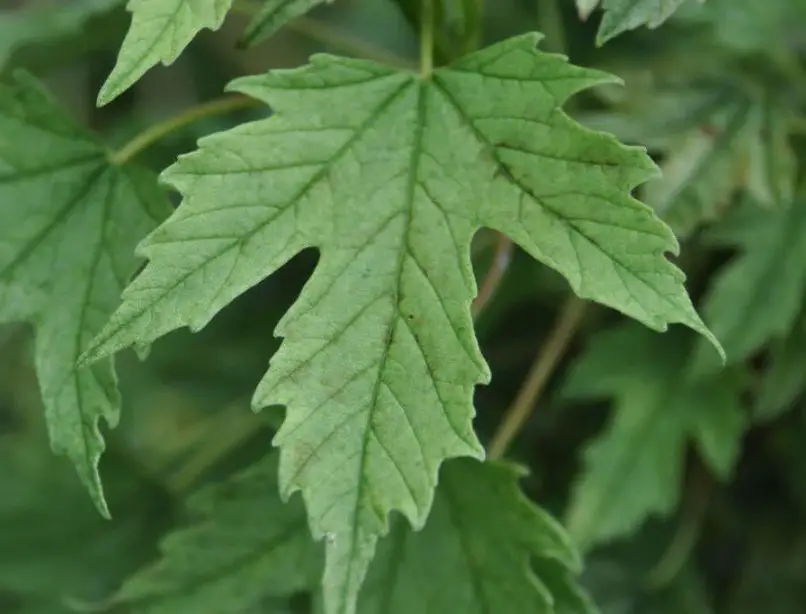
The ‘Brilliantissimum’ cultivar of sycamore maple is a small, slow-growing deciduous tree prized for its striking pink foliage. Its large leaves, with three to five lobes, emerge in salmon pink in spring, turn yellowish-green, and then cream in summer.
This ornamental tree reaches 20 to 30 feet (6–9 meters) tall and wide, thriving in cooler climates (USDA zones 4–7) in full sun or partial shade. Its bark is charcoal-gray, peeling to reveal an orange inner layer, adding to its visual appeal year-round.
Coral Bark Maple
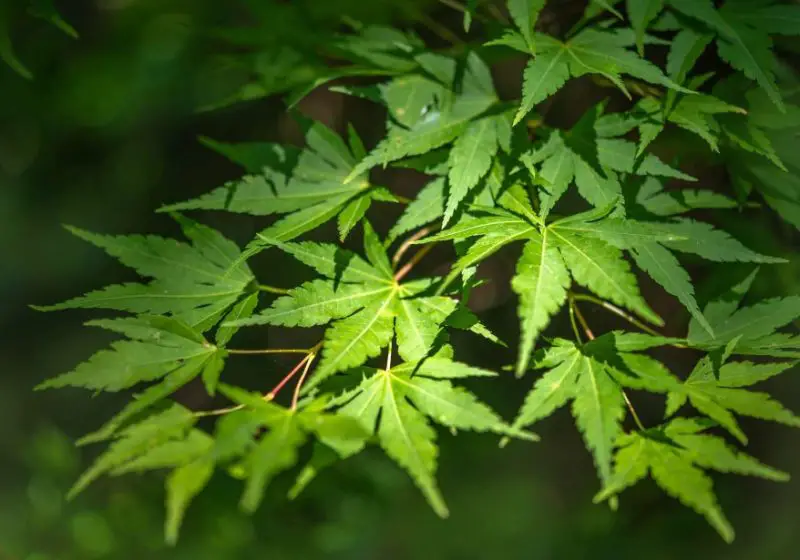
The coral bark maple (Acer palmatum ‘Sango-kaku’) is a stunning small maple known for its vase-shaped form and green leaves with red margins. The foliage, initially pinkish-yellow, transitions to green and then turns yellow-orange in the fall.
This ornamental tree thrives in USDA zones 4 to 8, reaching heights of 20 to 25 feet (6–7.5 meters) with a spread of up to 20 feet (6 meters). Its striking coral-red bark is especially vibrant during winter and spring.
Fernleaf Full Moon Maple
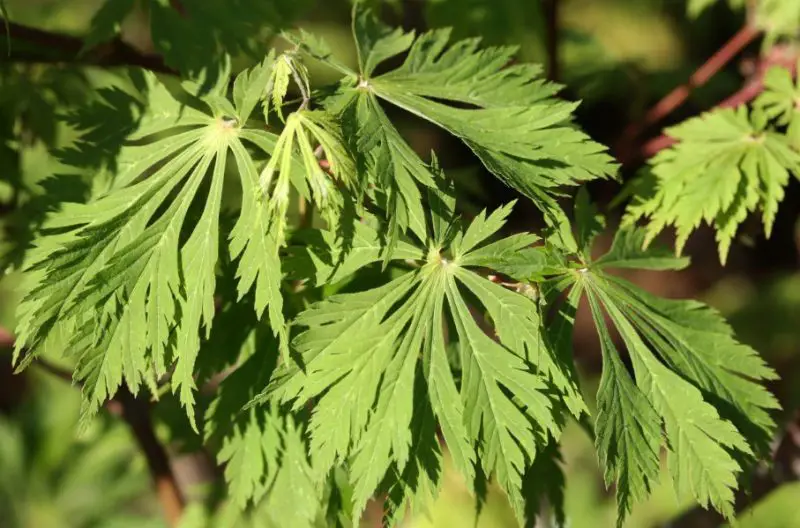
The Fernleaf Full Moon Maple (Acer japonicum ‘Aconitifolium’) is a compact deciduous tree prized for its delicate, feathery foliage. This small maple boasts finely-dissected palmate leaves with nine to 11 lobes, creating a lacy appearance.
Perfect for ornamental use, it reaches 7 feet (2.1 meters) tall and 10 feet (3 meters) wide. Ideal for USDA zones 5 to 7, it offers low-maintenance beauty, with leaves turning from green to vibrant hues of yellow, orange, and crimson red in autumn.
Variegated Box Elder Maple
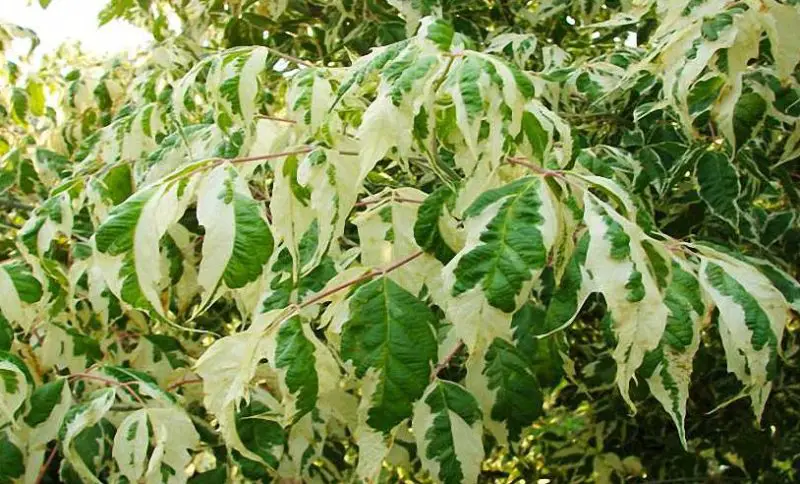
The Variegated Box Elder Maple (Acer negundo ‘Variegatum’) is a strikingly large tree adorned with creamy-white and green foliage. Known for its fast growth and upright habit, this maple forms a rounded canopy of distinctively pinnately compound leaves with three to five lanceolate leaflets.
Thriving in USDA zones 5 through 8 and reaching 40 to 50 feet (12–15 meters) tall and 25 to 35 feet (7–10 meters) wide in full sun, it stands out with its long samaras and interlocking ridged bark in shades of light to dark brown.
Japanese Maple ‘Katsura’
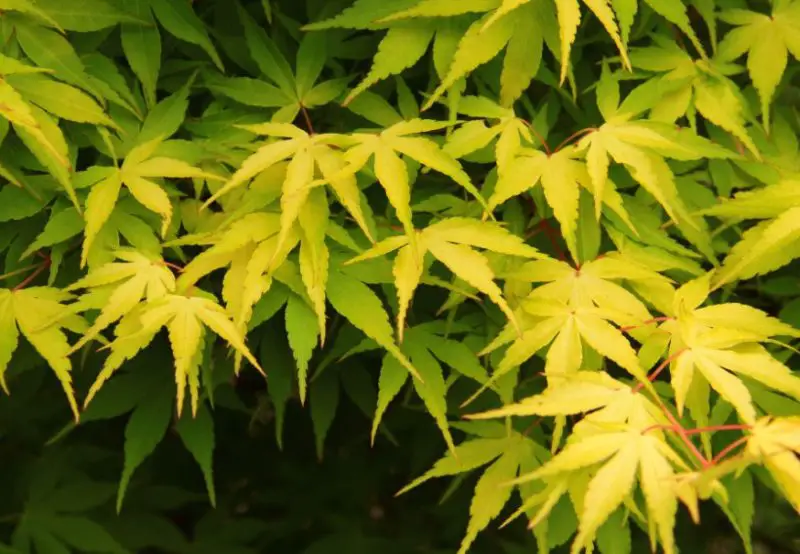
The Japanese Maple ‘Katsura’ (Acer palmatum ‘Katsura’) is prized for its ornamental value, featuring pink-edged orange leaves that transition from bright green to shades of orange and yellow in fall. Growing 5–9 feet . tall and wide, it forms a spreading vase shape, making it an ideal focal point in gardens.
Its palmate leaves, up to 5″ across, exhibit serrated strap-like lobes and are green with orange edges in summer. Bark starts red, aging to dark green or brown.
Laceleaf Japanese Maple ‘Garnet’
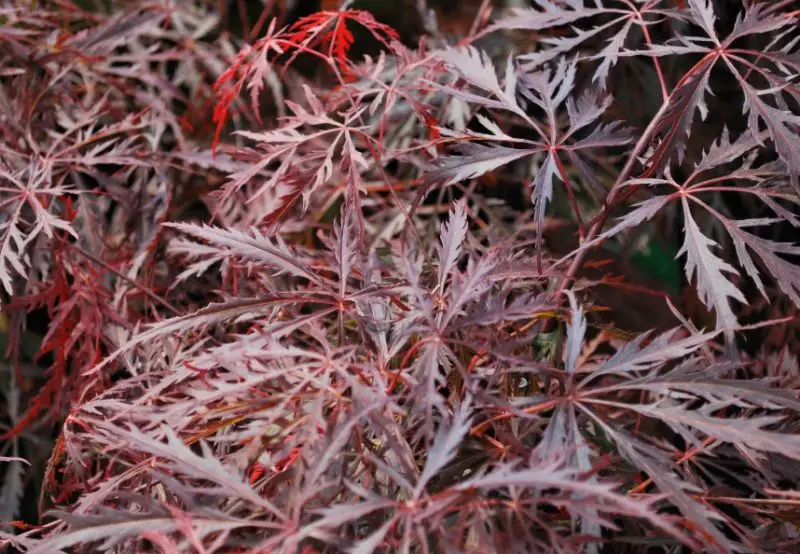
The Laceleaf Japanese Maple ‘Garnet’ (Acer palmatum var. dissectum ‘Garnet’) is a stunning dwarf maple with pinkish-red, deeply dissected leaves on arching branches. Its leaves turn red-orange before turning vibrant red in the fall. This mounding, shrub-like tree thrives in full sun to part shade, tolerating heat in USDA zones 5 to 9.
It grows 6–8 ft. tall and 12 ft. wide, making it ideal for southern gardens. The bark is smooth and pale gray to light brown.
Chalk Maple
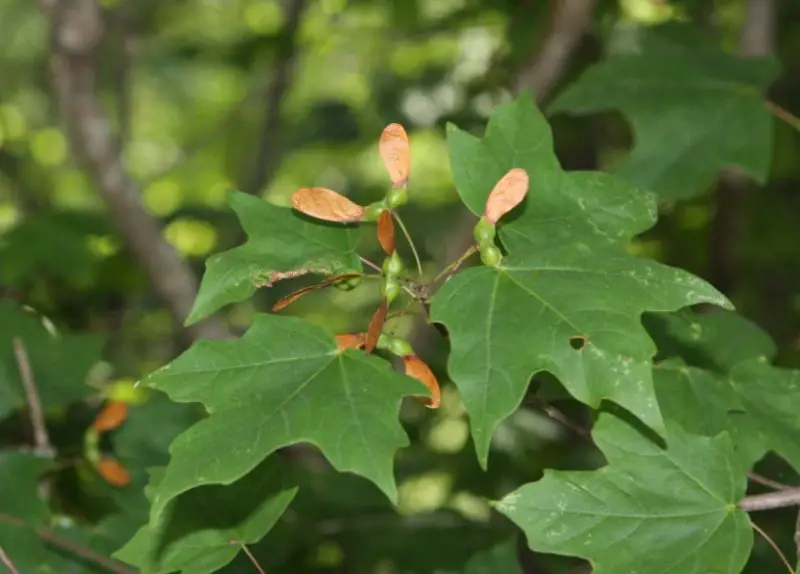
Chalk maple (Acer leucoderme) is a small deciduous tree, akin to the popular sugar maple but smaller in size. Native to North America, it is known for its light gray bark and symmetrical oval crown of dense foliage that turns yellow, orange, or red in autumn. Also called whitebark maple or pale-bark maple, this drought-tolerant tree reaches 25 to 30 feet (7.6–9 meters) tall and wide.
Its large leaves have rounded lobes, measuring 4 to 8 inches (10–20 cm) across, with slightly fuzzy undersides. Yellowish-green flower clusters adorn it in the spring. The bark of the chalk maple is distinctively light whitish-gray, developing ridges and turning charcoal gray as it matures.
Striped Maple
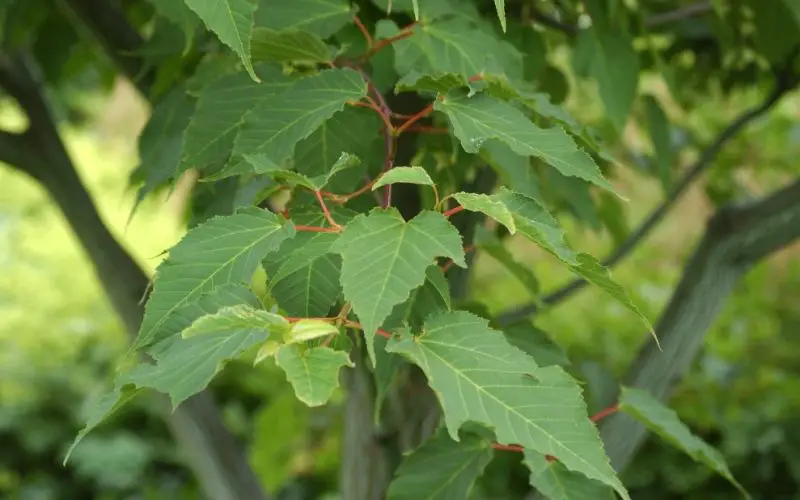
Striped maple (Acer pensylvanicum) is a small deciduous tree native to the eastern United States, admired for its broad, rounded shape with a flat, uneven crown. Growing 16 to 33 feet (5–10 meters) tall, it features leaves with shallow lobes resembling a duck’s foot.
The tree’s distinctive striped bark is smooth and green when young, adorned with vertical white stripes. As it matures, the bark turns brown with tan stripes. Also known as goosefoot maple, moosewood, or moose maple, this maple adds unique charm to woodland landscapes with its striking bark and distinctive leaf shape.
Mountain Maple
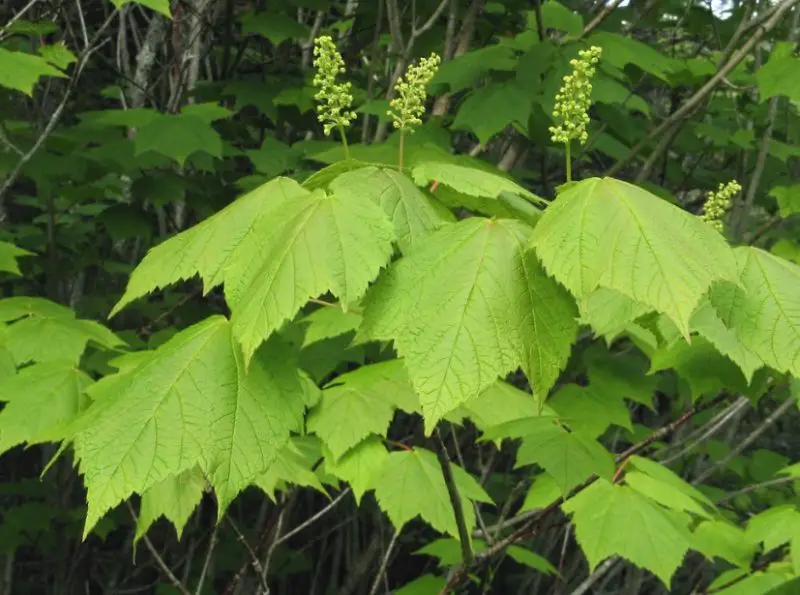
Mountain maple (Acer spicatum) is a large shrub or small tree with light-green foliage, spreading 10 to 25 feet (3–8 meters) tall. Known for its three- or five-lobed leaves on slender stalks, gray-brown bark, and reddish-tan samaras, it thrives in moist woodlands.
Also called dwarf maple, moose maple, or white maple, this understory tree produces sweet sap for maple syrup. Its leaves have irregularly toothed margins and finely hairy undersides, turning yellow, orange, and red in autumn. Bark starts smooth, becomes scaly, and darkens to brown with age.

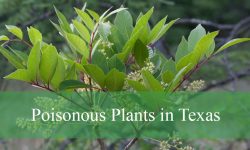
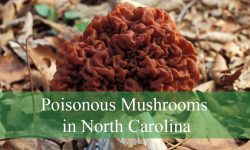




I found a new “tree” in our raised garden bed, & have saved it as I haven’t found any “parent plant” in the neighborhood. Leaves are akin in appearance to the Sycamore Maple, & the ‘crown stem’ has a cluster of round buds which are bursting with a red petaled flower. Can you ID from this description ? I will attempt to obtain a color photo for you in tomorrows daylight if needed. Thank You !!
Here’s a couple of pic.’s that I took today of our “find” which is suspect of being planted by a bird into our raised bed garden. The wife transplanted to a porch planter, & it’s really taken off. What I thought was red flowers turned out to be new leaves, & the tiny ball buds are showing a cluster of yellowish tiny orbs. HMMMmmmm. The photos won’t load ! How can I show you what we have ??
Hi there, pls send me via email. You can submit by contact page. Thanks for visit my blog.